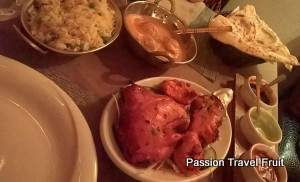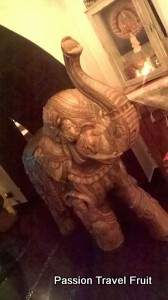ITALY - ROME Tasting India with the 7 senses / Saboreando a Índia com os 7 sentidos
- By Gaia
- 11 de jan. de 2015
- 4 min de leitura

ENGLISH - Rome is a multicultural and multiethnic city. Exploring food in the New Year, my desire to discover India went beyond the simple look of the map of the country and many reading on historical facts, culture and customs of this fascinating and diverse country.
In Via Palermo 6B (close to the main Via Nazionale, metro stop Repubblica) I found IndianAffairs, a fusion of tradition and contemporary India, offering a rich menu of chicken, lamb, rice, vegetarian and vegetables dishes, along with the traditional Nan-bread to accompany sauces and spices as appetizers, and lassi to drink flavory yogurt all along the night.
The atmosphere and the hospitality of the Indian Affairs staff is simply incredible. Soft lighting, comfortable and enjoyable location, I was mesmerized by the culture inside the restaurant.
Four elements stroke me. First, a giant elephant at the entrance. In Hinduism culture, the elephant is often associated with the Hindu god deity of Lord Ganesha, the Elephant God. Ganesh, as most commonly called, is an elephant-headed god that represents perfect wisdom, and also considered as remover of obstacles and bestower of prosperity. Ganesha is also called Ganapati: Ga means “knowledge”, na means “salvation” and pati “lord”. As a religious symbol, the elephant is Asian, representing royalty, power, wisdom, fertility and longevity. In modern India, festivals honoring the elephant-god are celebrated yearly.
Second, a miniature of the Harmandir Sahib. The Harmandir Sahib, also called “the Golden Temple” is a place of worship for the Sikhs, followers of Sikhism, a monotheistic religion which originated in the 15th century in the Punjab region. The temple is all made of gold and has four doors, which symbolize the openness of Sikhs towards all people and religions.
Third, statues, frames of Hindu deities : in every restaurant room there are a number of deities, and it would be interesting to know all the iconography behind them, discovery time!
Fourth, the Color and senses: Love is in the menu, colors, staff and chefs. The choice of natural, fresh and quality ingredients make each dish a combination of flavors that awaken the senses. The red color is found in the lightning, on the walls, In the roses on the tables with roses.
Simply put: all around the table, bringing people together to discover food and culture.
Affordable prices, smiles and aromatic sweet fennel seeds with mint candies as free treats. As the menu says: “Cooking is like Love. It should be entered into with abandon or not at all”- Harriet Van Horne
Highly recommended for a romantic dinner!
Here’s the website http://www.restaurantindianaffairs.com/
Ciao!

PORTUGUÊS - Roma é uma cidade multicultural e multiétnica. Explorando novas comidas no novo ano 2015, o meu desejo de descobrir a Índia chegava além da simples leitura do mapa do país e de muitos fatos históricos, culturas e costumes deste país fascinante e diversificado.
Na Via Palermo 6B (perto da Via Nazionale, parada de metro: República) há o IndianAffairs, um restaurante que representa uma fusão entre a Índia tradicional e a contemporânea, oferecendo um cardápio com opções de frango, de cordeiro, de arroz, de pratos vegetarianos e de legumes, juntamente com o Nan, um pão tradicional para acompanhar com molhos e temperos e o lassi para beber um saboroso iogurte ao longo da noite. A atmosfera e a hospitalidade da equipe do Indian Affairs é simplesmente incrível. Iluminação suave, confortável e localização agradável, fiquei fascinada pela cultura no interior do restaurante.
Quatro elementos me agradaram muito. Em primeiro lugar, um grande elefante na entrada. Na cultura do Hinduísmo, o elefante é muitas vezes associado com a divindade hindu de Lord Ganesha, o deus-elefante. Ganesh, como mais é comumente chamado, é um deus com cabeça de elefante que representa a sabedoria perfeita, e também é considerado como removedor de obstáculos e doador da prosperidade. Ganesha é chamado Ganapati anche: Ga significa "conhecimento", na significa "salvação" e pati "senhor". Como símbolo religioso, o elefante é asiático, o que representa a realeza, poder, sabedoria, fertilidade e longevidade. Na Índia moderna, festas em honra do deus-elefante são comemoradas anualmente.
Em segundo lugar, uma miniatura do Harmandir Sahib. O Harmandir Sahib, também chamado de "o Templo de Ouro" é um lugar de culto para os Sikhs, seguidores do Sikhismo, uma religião monoteísta que se originou no século XV, na região de Punjab. O templo é todo feito de ouro e tem quatro portas, que simbolizam a abertura dos Sikhs para com todos os povos e religiões. Em terceiro lugar, estátuas, quadros de divindades hindus: restaurante em todos os quartos, há uma série de divindades, e seria interessante saber toda a iconografia atrás deles, o tempo de descoberta! Em quarto lugar, os Sentidos e as Cores: O amor está no cardapio, nas cores, no pessoal e nos chefs. A escolha de ingredientes de qualidade, naturais e frescos fazem de cada prato uma combinação de sabores que desperta os sentidos. A cor vermelha se encontra no relâmpago, nas paredes, nas rosas sobre as mesas .
Simplificando: todos na mesa, reunindo as pessoas para descobrir comida e cultura.
Os preços são acessíveis, tem doces de graças com sementes de erva-doce e com doces de hortelã. Como o cardapio diz: "Cozinhar é como o amor. Ele deve ser assumido com intensidade, é tudo ou nada "- Harriet Van Horne
Altamente recomendado para um jantar romântico!
Aqui está o site http://www.restaurantindianaffairs.com/
Ciao!





Comments